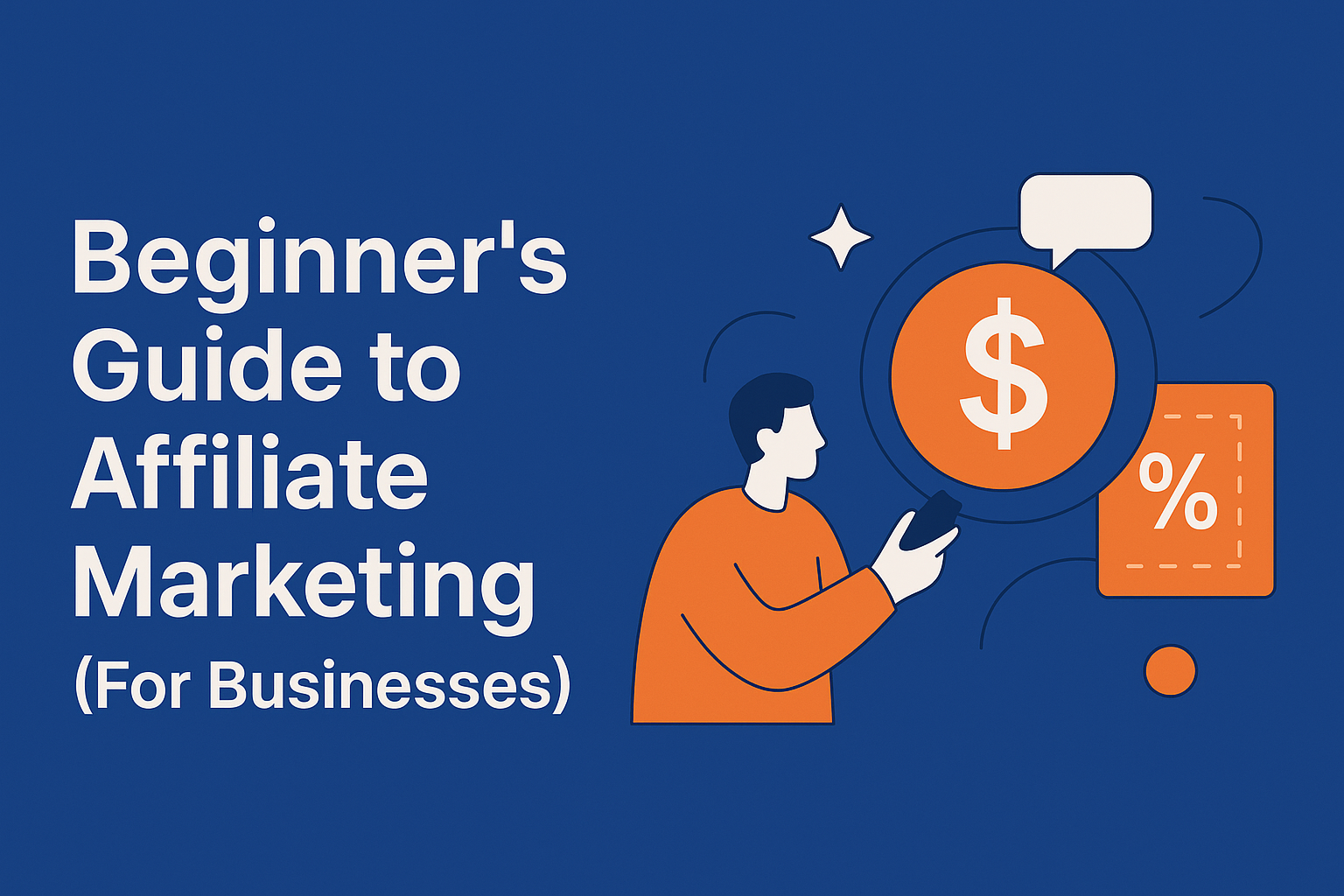ntroduction
Affiliate marketing has become one of the most effective and low-risk strategies for growing online businesses. In 2025, companies are shifting their focus toward partnerships that deliver measurable results and affiliate marketing stands at the center of that revolution.
Instead of spending huge budgets on ads with uncertain returns, affiliate programs let brands pay only when they get real sales or leads. It’s a win-win model: affiliates earn commissions for promoting your products, while you expand your reach without extra marketing costs.
This guide will walk you through the fundamentals of affiliate marketing for businesses from how it works to how to create a program that attracts top partners and drives consistent revenue.
1. What Is Affiliate Marketing?
Affiliate marketing is a performance-based system where businesses reward individuals or other companies (known as affiliates) for bringing in customers or sales through their marketing efforts.
The process works through unique tracking links that allow businesses to identify which affiliate generated each sale or lead. When the customer completes the purchase, the affiliate earns a commission.
It’s a simple concept but when executed strategically, it can become a major source of scalable income and brand visibility.
2. How Affiliate Marketing Works
Affiliate marketing runs on a simple partnership model between three main players:
-
The Merchant (You): The business that sells products or services.
-
The Affiliate (Partner): The individual or brand promoting your product.
-
The Customer: The end user who clicks an affiliate link and makes a purchase.
Here’s how the process typically unfolds:
-
You create an affiliate program with commission structures and rules.
-
Affiliates sign up and promote your products using special tracking links.
-
Customers click those links and make purchases.
-
The system tracks the transaction and pays commissions to affiliates.
This structure benefits everyone — affiliates earn income, customers discover quality products, and you increase sales efficiently.
3. Setting Up an Affiliate Program
Before launching an affiliate program, it’s essential to plan strategically. Your goal is to design a system that attracts quality partners and motivates them to perform.
Key steps to setting up an affiliate program:
-
Choose an Affiliate Platform: Use trusted platforms like ShareASale, Impact, or your eCommerce software’s built-in affiliate tool.
-
Define Commission Rates: Offer fair percentages that balance profitability with motivation — typically 10–30% depending on your niche.
-
Set Rules and Terms: Clearly outline payment frequency, cookie duration, and restrictions (like not using brand keywords in ads).
-
Provide Creative Assets: Give affiliates banners, images, and sample content to make promotion easy.
Once your system is ready, invite affiliates to join through your website or social media channels.
4. Finding the Right Partners
Not all affiliates are equally valuable. The success of your program depends on finding partners whose audience aligns with your target customers.
Here’s how to identify the right ones:
-
Look for bloggers, influencers, or YouTubers who already create content in your niche.
-
Check their engagement metrics — not just follower count but real interaction.
-
Collaborate with affiliates who share your brand’s tone, ethics, and authenticity.
Best practices for choosing affiliates:
-
Relevance: Their audience should match your ideal buyer profile.
-
Credibility: They should be trusted voices within their community.
-
Transparency: Avoid partners who use spammy or misleading tactics.
Building long-term relationships with genuine partners ensures consistent results and protects your brand’s reputation.
5. Tracking and Managing Performance
One of the major advantages of affiliate marketing is its measurability. Every click, conversion, and sale can be tracked in real-time.
Modern affiliate platforms provide detailed dashboards where you can monitor metrics like traffic sources, conversion rates, and top-performing affiliates.
Use this data to:
-
Identify which affiliates bring the best ROI.
-
Optimize your promotional materials.
-
Adjust commission rates to reward high performers.
Performance tracking helps you focus your efforts where they matter most, ensuring that every dollar spent leads to tangible growth.
6. Tips for Scaling Your Program
Once your affiliate program gains momentum, scaling becomes the next step. Growth doesn’t mean adding hundreds of affiliates overnight—it’s about strengthening the system.
Effective ways to scale your affiliate marketing:
-
Offer Tiered Rewards: Give higher commissions to top performers.
-
Create Seasonal Campaigns: Use holidays or product launches to boost affiliate activity.
-
Provide Training: Teach affiliates how to market your brand effectively.
-
Reward Loyalty: Recognize affiliates who consistently deliver results.
Scaling is about building partnerships that last. When affiliates feel supported and valued, they promote your brand more passionately.
7. Common Mistakes to Avoid
While affiliate marketing sounds simple, many businesses make critical mistakes that limit their success.
Avoid these pitfalls:
-
Neglecting Relationship Building: Affiliates are not just salespeople they’re your brand ambassadors. Communicate regularly.
-
Ignoring Fraud Monitoring: Some affiliates may try to manipulate tracking systems. Always verify leads.
-
Offering Weak Incentives: If your commission is too low, affiliates won’t stay motivated.
-
Lack of Promotion Support: Affiliates perform better when given materials and updates.
By staying proactive, you ensure your program runs smoothly and profitably.
8. Integrating Affiliate Marketing with Other Channels
Affiliate marketing works best when integrated with your overall digital strategy. It complements your content marketing, SEO, and social media efforts by expanding your reach and credibility.
For instance, when affiliates create blog posts or videos about your product, they generate valuable backlinks boosting your SEO rankings. Meanwhile, social media collaborations amplify visibility and brand awareness.
Treat affiliates as an extension of your marketing team, not a separate entity. The synergy between all channels leads to exponential growth.
9. Using AI and Automation for Affiliate Success
In 2025, artificial intelligence has transformed affiliate management. AI tools now help businesses detect fraud, predict top-performing affiliates, and automate payouts.
Some advanced systems even use AI to recommend content strategies based on customer behavior and purchase trends.
Automation tools can handle routine tasks like link tracking, communication, and report generation, freeing you to focus on relationship-building and creative strategy.
When used wisely, AI can turn a small affiliate program into a well-oiled marketing machine.
10. Measuring Long-Term Success
Affiliate marketing is not a one-time campaign—it’s a continuous process. Measuring long-term results helps you understand its true impact on your business.
Focus on metrics beyond immediate sales, such as:
-
Customer lifetime value (CLV) from affiliate referrals.
-
Growth in website traffic from affiliate backlinks.
-
Brand awareness across social and content networks.
When managed well, affiliate marketing doesn’t just bring revenue it builds a loyal customer base and community of brand advocates.
Conclusion
Affiliate marketing in 2025 is one of the smartest growth strategies for businesses of all sizes. It offers scalability, low risk, and measurable results something few marketing channels can guarantee.
By building genuine partnerships, tracking data effectively, and offering fair rewards, your brand can create a powerful ecosystem where everyone wins.
Whether you’re launching your first program or optimizing an existing one, remember this: affiliate marketing is about relationships, not transactions. The more trust you build with your partners, the stronger your business foundation becomes.


